The Loop
Michigan, United States of America
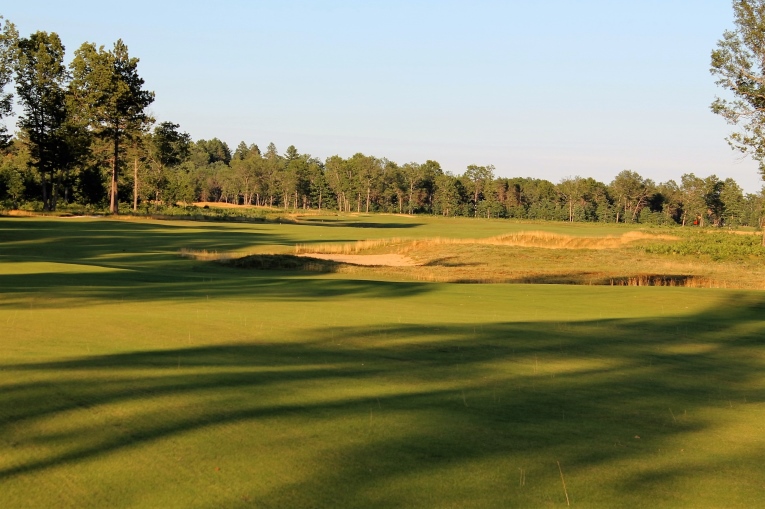
To work suitably in both directions, the features across the course are low profile. The result is a course that lays quietly on the ground with the experience reminding the author of a stroll around a pleasant, uncluttered English countryside course.
When Tom Doak was inducted into the Michigan Golf Hall of Fame in 2013, he incidentally mentioned that he had been fortunate to work on projects around the world but it would sure be nice to work close to his home in Traverse City, Michigan. The very next day, two of his friends who had been in attendance were at the Forest Dunes resort (a one hour drive from Doak’s home) when the General Manager remarked they were considering building a second course. Talk about serendipitous timing!
Lew Thompson, Forest Dunes’ new owner, met shortly thereafter with Doak and made it clear that he wanted a course that people would want to play the next day and that would wow them. After all, reasons must exist to motivate people to make the drive to this part of northern Michigan, about three hours north of Detroit.
Against those parameters, Doak knew what he wanted to propose: a reversible course. After reading in the 1980s Tom Simpson’s and Roger Wethered’s cornerstone The Architectural Side of Golf including Appendix I which diagrams and extols the values of a reversible course, Doak had been biding his time for the right opportunity and this was it. The terrain was gentle (after all, a hole over dramatic land like the ninth at Yale only plays well in one direction), the soil was sandy (which facilitates construction) and there weren’t many specimen trees.
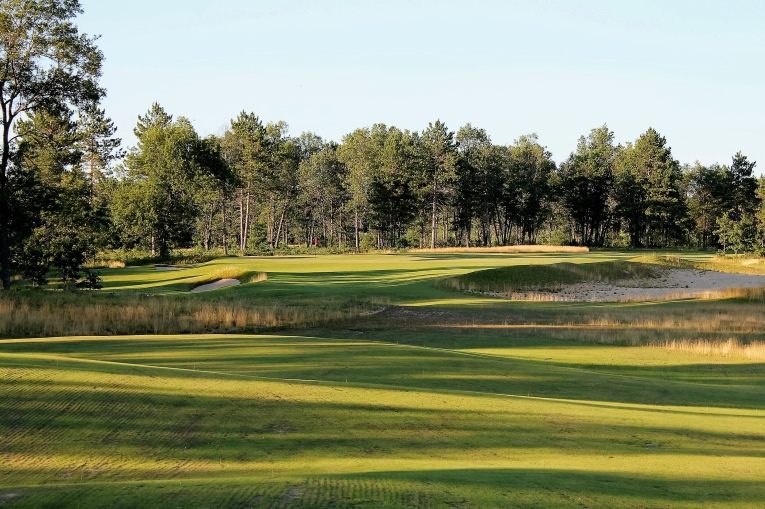
This photo of the 193/179 yard Black 15 puts a tick in the box for gentle land, sandy soil, and few specimen trees.
Doak left the meeting and worked on the routing for a month. When asked how hard was it to create a course that could play both ways, he said, ’Given the characteristics of the property, not that hard. The purpose of the routing was to find the interesting natural features. I always knew that for the second course (I hate calling it the ‘backwards’ course as that is somehow demeaning) that emphasis would have to be placed on man-made features to help ensure it was as good as the course for which I did the primary routing.’
Doak subsequently presented his plan for today’s Red Course, which plays counterclockwise. After Thompson reviewed it, Doak plunked down the Black Course, which plays clockwise. Thompson loved the notion of a reversible course and immediately grasped its host of benefits. You use essentially the same amount of land, pay for 18 greens and get two courses. To play both – and who wouldn’t? – you have to stay the night at the resort (no chore since the accommodations are what golfers hope for – comfy beds, big televisions and large shower heads). The concept which virtually guaranteed revenue from lodging, food and beverage was quite compelling to Thompson.
Construction began in the fall of 2014 which enabled the seeding of the entire course by the following September. Brian Slawnik ran the project and Brian Schneider and Eric Iverson did most of the green and bunker shaping. Also, Angela Moser spent much of the 2015 summer there and was responsible for a considerable amount of tee and bunker shaping and finish work. Slawnik, who had recently completed Tara Iti in New Zealand was thrilled to now also work close to home. The course opened for limited play in June 2016.
It may all sound wonderful but ultimately the architect must deliver a reversible design in which both eighteen hole layouts are rife with compelling golf. If not, the project becomes a gimmick that will be discarded over time. Also, if one course is significantly better than the other, the hoped for additional revenue stream from food and lodging fails to materialize as golfers drive up for the day to play the one ‘good’ course. As Brian Slawnik notes, ‘If we did what we set out to do, you will only be thinking about how good the golf is on the hole you are presently playing. It doesn’t matter that it is a reversible course. Yes, the concept is terrific from a land and water use perspective but if we were successful, The Loop really just becomes two golf courses.’

Great holes needed to emerge for the project to be a success. One look at Black 13, a beastly 222 yard one shotter, shows that occurred.
How should a reversible course function? Doak had no interest in going the St. Andrews route of double greens and 150 yard wide fairways. While he had tinkered with a reversible course at the free-form Sheep Ranch there was no real precedence; to the casual golfer, confusion reigns.
The simplest way to explain it is that there are eighteen greens, eighteen flags, and the counterclockwise course is played one day and the clockwise course played the next. To repeat, there is only ever one flag per green. Over two days of play, each green is approached from two significantly different directions. For example, Red 4 is a 187 yard one shotter that plays into the southwest corner of the property. Its green enjoys many Redan characteristics as the land tilts from right to left. It’s a very fine hole that would be a welcome addition on most courses.
Its ‘cousin,’ the 489/430 yard Black 14 approaches the Red Redan green from 90 degrees, meaning that the Black 14 putting surface tilts from back to front toward the golfer in the fairway. Doak & Co. consider Black 14 the most difficult par on the property.
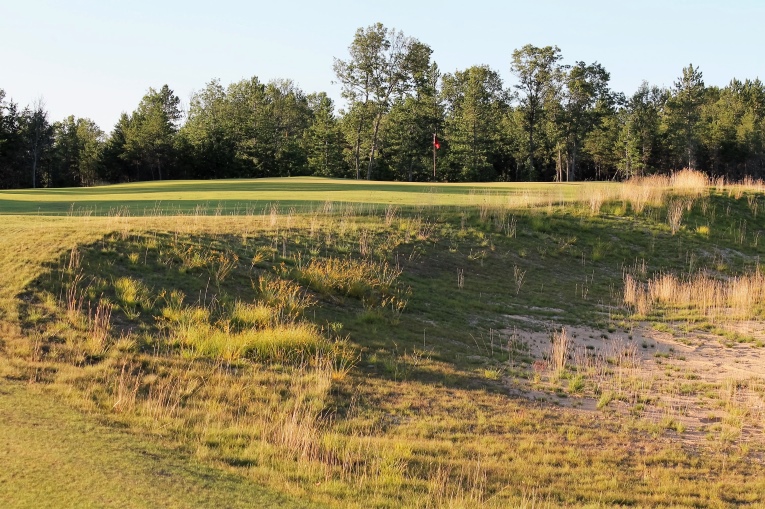
… that scampers past this attractive hazard 60 yards short right of the green. From this direction, the green is much more deep than it is wide.
Does it work having two holes meet at a right angle to a common green? As presented above, yes! Both Red 4 and Black 14 are among the best holes found at The Loop. The green asks markedly different questions depending on which direction you approach it and the only common theme is the preeminence of the ground game. So, one combination down – seventeen to go! What a daunting challenge but one that was at the crux of the project’s success.
Another prime example of how a green (singular) works well for two holes occurs at Black 6/Red 12. Red 12 heads to the south through a little valley before rising to a green that starts at grade before becoming a menacingly narrow plateau. One of the very best greens anywhere, let alone on the course, some whisper 5 at Royal Worlington & Newmarket. Mindful of its taxing demands, Doak & Co. saw to it that Black 6, which approaches the green from the west, is a reachable par 5 of 514/483 yard. Played from this direction to a wide but shallow shelf, the green reminds some of 12 at St. Andrews. Par is indeed admirably defended at the green on both holes that are modest lengths for their respective pars.
According to Brian Schneider,
The most unusual aspect of this project was the need to think about approach shots coming into the greens from a much wider variety of angles than normal. We always consider the 360* contouring of our green complexes as they relate to the way shots might react when they land and for recovery play, but at Forest Dunes, the thought that went into the shaping of the greens and approaches was much more complex because the angles of attack were so broad and varied. Given the expansive way we had to view each green, “Red” and “Black” weren’t a part of the construction lexicon, and I still struggle to sort out which hole is which by number. We referred to the holes based on features like “the shallow green with all the bunkers, but from the other direction” and geographically like “that one that plays into that corner over there.” Fun, but it also made my brain hurt.
For Brian Slawnik, the stretch from 10 Red through 13 Red (also known as 5 Black to 8 Black!) is one of his favorite portions of the property, noting that, ‘We made great use of the valley and the greens at 12 and 13 Red are some of our best work anywhere. 13 Red/5 Black is in a prominent position on the course so it was really important that it ended up looking so good from all directions.’
One thing quickly became evident: there would be a massive among of short grass. The reason? The first 150 yards off each tee is maintained as short grass so that it can function as fairway in the other direction. This results in a whopping 90 acres of short grass, nearly 50% more than a typical Arizona desert course.
What about the pacing of the courses? Fascinatingly, they are the exact opposite. Red starts with a short par 4 and a get-able par 5 and concludes with a wonderful par 3 and a brutish down and up long par 4 while the Black begins tough and ends with a pair of birdie-able holes. That’s pretty neat as it speaks to the fact that each course enjoys its own distinct character.
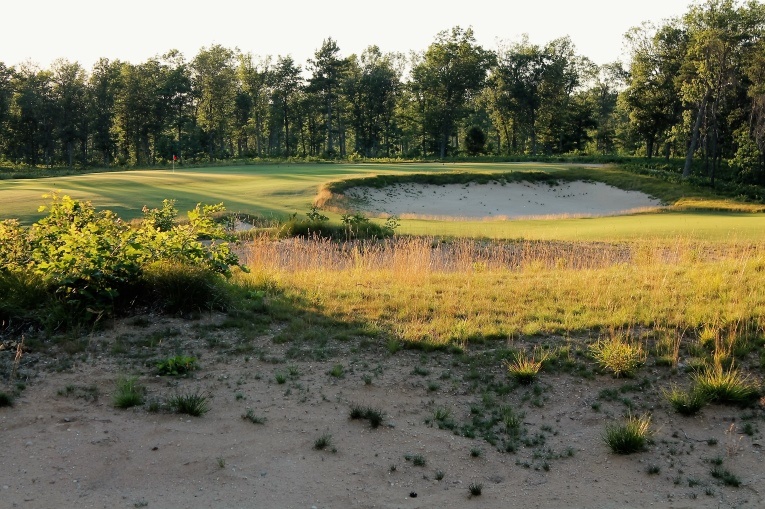
The opening hole on the Red is a driver, flick hole where one needs to avoid the course’s biggest hazard short right of the green.
People are naturally going to compare one to the other and argue for their favorite. That’s certainly a prerogative but Doak thinks of The Loop as one entity. He advised Ron Whitten that Golf Digest should rate it as such. The important thing is that the relative merits of the two courses become a lively debate. Based on the limited play that has been allowed as of this writing (August, 2016), the results are almost evenly divided so, mission accomplished!
Here the ground game rules and is facilitated by the fescue fairways which thrive in the course’s northern Michigan climate and cool evenings. The greens are bent, like the resort’s other course designed by Tom Weiskopf, that has long been heralded for its conditioning, especially the putting surfaces. Given the ground game’s importance, the course is user-friendly to a class of player largely ignored by designs built from 1970 to 2000 (i.e. children, women, less skilled players and seniors). Indeed, the strong player accustomed to overcoming most designs with length is more apt to become frustrated here because some of the fallaway greens like Black 7 and Black 12 will get under his skin.
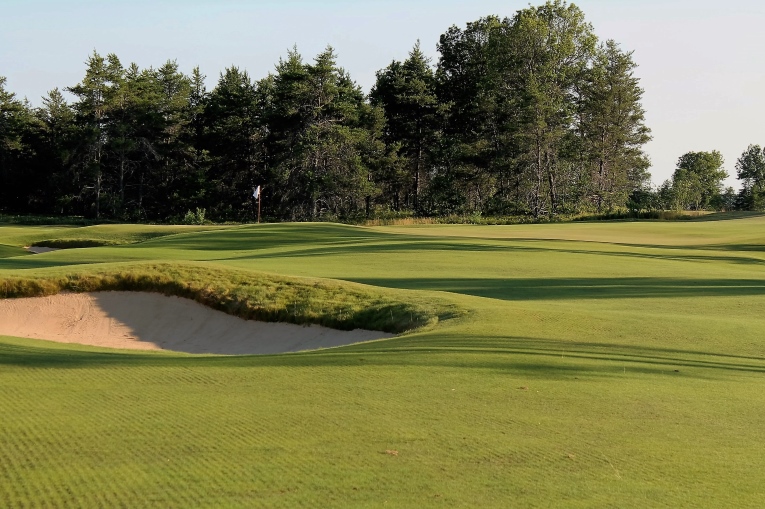
Like St. Andrews, the fallaway greens enable vexing hole locations. The tricky back left hole location on Black 7 is seen above.
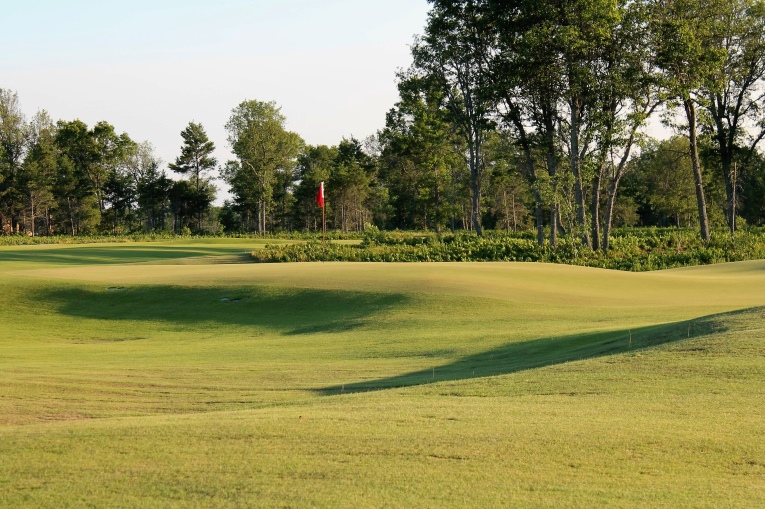
Red 2 plays 551/529 yards and though bunkerless, the green has plenty of defenses thanks to the firm, running conditions provided by Green Keeper Brian Moore. For Black 16, the green is approached from 90 degrees to the right, meaning that the trough that bisects the green is now perpendicular to play and that the green qualifies as a Biarritz.
Slawnik perfectly captures the essence of the project when he notes, ‘In the end, the project helped reaffirm to us all just how good golf can be on subdued land. You can do A LOT with two feet of cut and fill. Look no further than the swale and ridge that feed into 10 Black as an example of how an approach becomes very interesting even if there are no bunkers.’ Same for Red 2 above.
One benefit is how this design eliminates most greenside mounding. Such mounds are the plague of modern design whereby green complexes are ‘framed’ around the sides and back by insipid lumps that add no value to the golf and that only serve to detach the hole from nature. Of course, Doak has long railed against such features and this design conspicuously lacks such abominations. An exception occurs at Black 4, ironically (!) Doak’s favorite of the 36 holes, where mounds are in front of the green and tactically of use as opposed to their typical lame placement behind greens. When playing The Loop, it’s enlightening to learn when and where man-made features are most effectively employed.
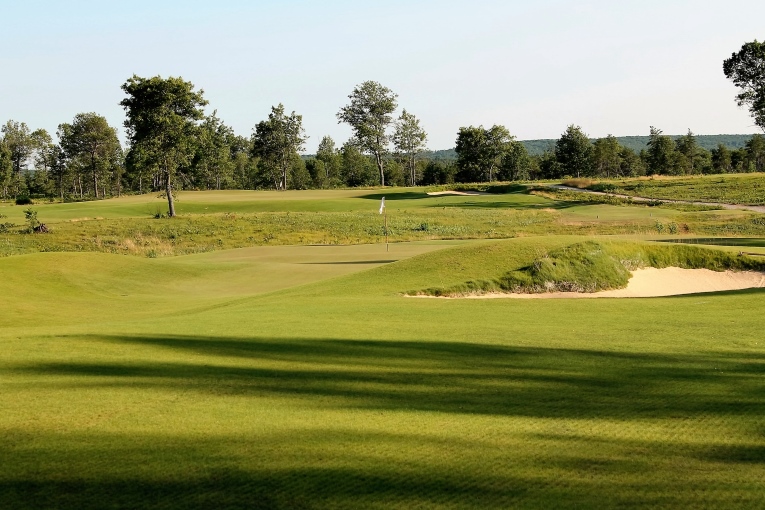
Refreshing to see mounds put to good use, namely at the front of a green. As seen above, if the golfer finds the left portion of Black 4 fairway, he enjoys a great look down the length of the green on this 348/324 yard hole. Any approach from the right side must carry the lone fronting bunker and find the putting surface hidden from view. These mounds are at the back of Red 14 where their impact on play is less pronounced.
Apart from greenside mounds, what else would not have worked? A heavily fortified green for a short-ish hole one way would likely be a poor target for a big two shotter from another direction. Also, getting numerous central hazards to look good in all directions seems improbable as you would be building the hazards onto the land rather than into it. Finally, narrowness needed to be shunned as it rarely works well in one direction, let alone two.
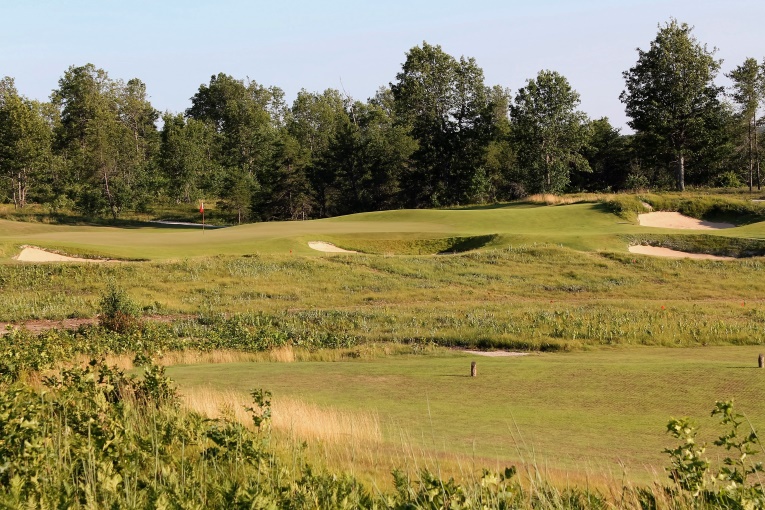
Red 6 calls for is 125 yard pitch to a tightly defended green. Such a green would only work coming the other way if the required approach was reasonably modest in length. Importantly, Black 12 fits the bill as a 381/321 yard downhiller.
Other interesting tidbits about this unique project: tee boxes can be smaller as they are only employed every other day. On a reversible course, if there are cart paths, tees must be located on the perimeter of the property, the only reasonable loci for golf cart paths. Fortuitously, The Loop’s owner went to Bandon and came away mightily impressed by the walking ethos at that booming resort. Subsequently, he notified Doak that The Loop would be walking only. That freed up the possibility for teeing grounds on the interior of the property.
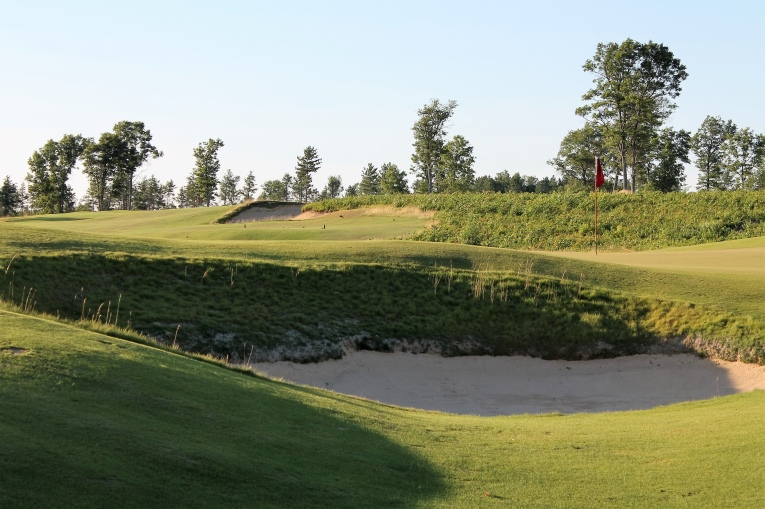
As seen from behind Red 6, an exciting tee presents itself for this hole above the bunker in the background, made possible only if the tees don’t have to be slavishly close to cart paths.
It stands to reason that unique features would develop from this one-off situation. To the author, Doak has never built a hole quite like the 442/392 yard Red 8, where 70 yards from the green a large swath of vegetation walls-off the fairway creating a forced carry. This is very uncharacteristic for Doak who generally gives players an out. Yet, this hole is improved by such; some might be reminded of the mighty sixth at Sunningdale Old where the second shot must scale a bank of heather.
Finally, one of the most fascinating elements that emerged occurred at the 184/138 yard Red 17. In no uncertain terms, it reminds the author of one of the most heralded one shotters in the United Kingdom, 16 at Royal North Devon. Both greens are domed and shed balls with great aplomb. No window dressing is required at either but Westward Ho! has the time stamp of approval in its favor. While exquisite, Red 17 might appear a bit plain, at least before the tee ball, as the hole’s one bunker is well left from play. Doak remarks, ‘I got away with leaving this hole this clean and simple-looking because a killer par 4 comes in the other way.’ In many ways this hole epitomizes the entire project: there is nothing goofy at all about a reversible course and, in fact, it elucidates what is and isn’t important in good design.
The biggest takeaway from The Loop is that you want to return. Your mind has been expanded and it’s impossible to digest all the permutations on the property in a mere 24 hours. In 1929 Simpson and Wethered thought it was an obvious tack to pursue given that it had worked well for decades at places like North Berwick and St. Andrews. Per Simpson and Wethered, ‘…there seems to be no very convincing reason, provided the conditions are favourable, why a method approved in the past should not be revived with even greater advantage in the present.’
You might arrive at Forest Dunes wondering what a reversible course is all about but you will leave surprised that there aren’t more such courses being banded about.
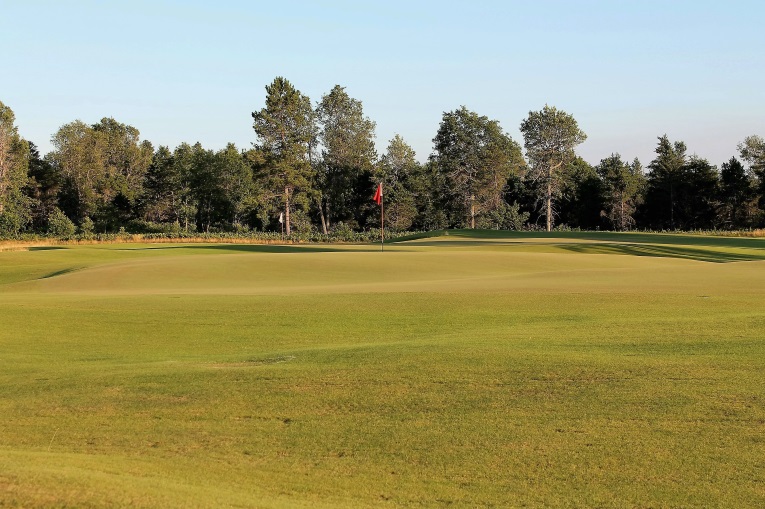
As at the world’s most famous reversible course in Scotland, the flags are white going out and red coming home.
The End


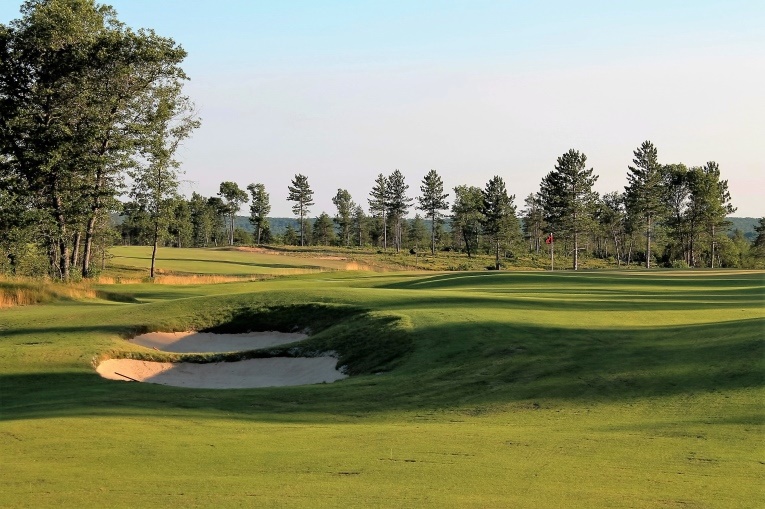
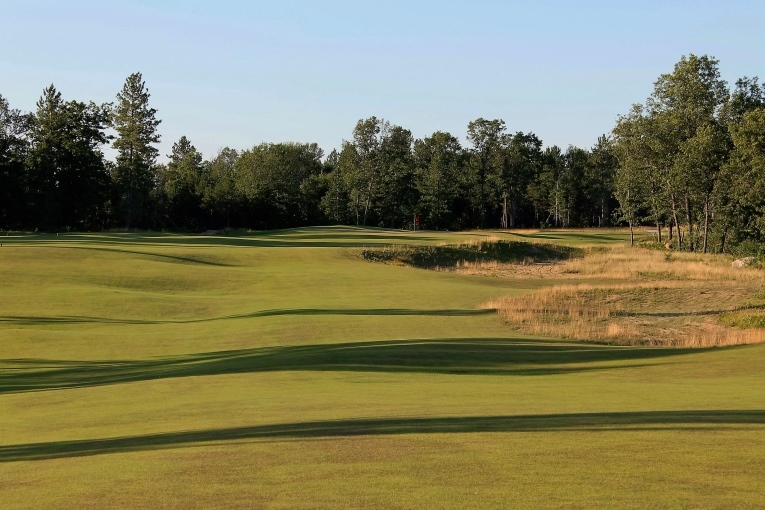
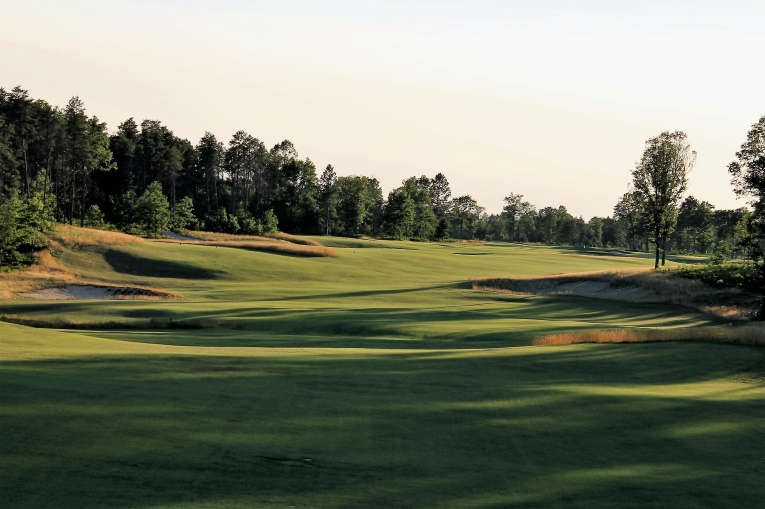




![The Park, West Palm (Lit 9) [2023]](https://golfclubatlas.com/wp-content/uploads/2024/12/IMG_7092-2-scaled-500x383.jpg)


